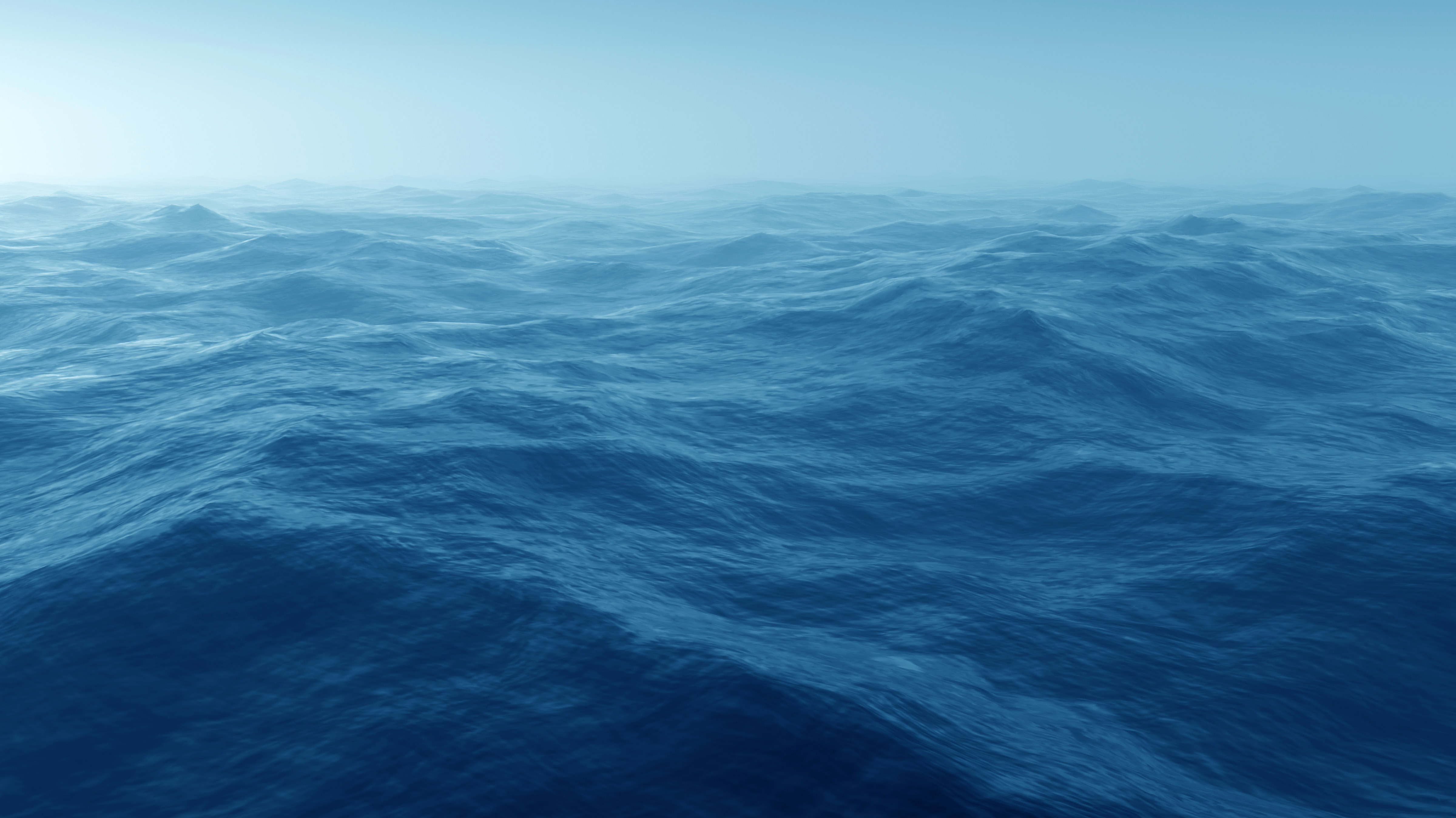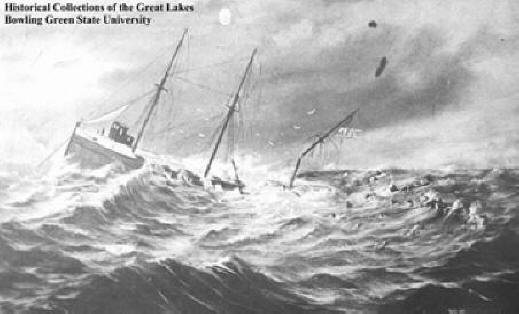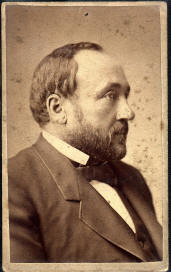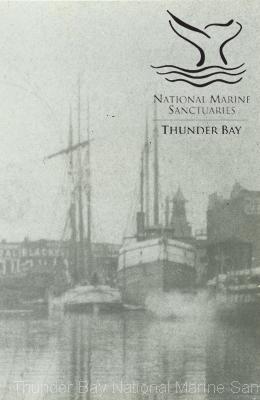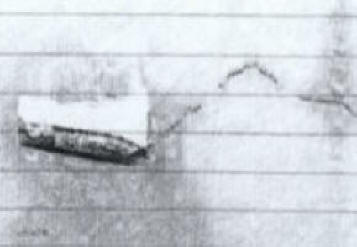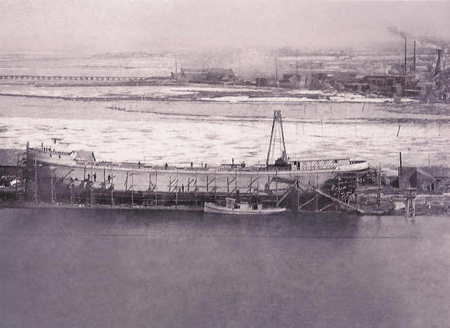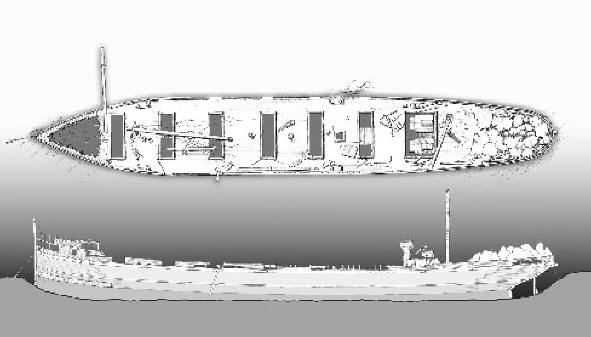N 42° 39.525′, W 086° 31.700′
The H. C. Akeley was built at Mechanics Dry Dock by Thomas W. Kirby and Healy C. Akeley in the once-busy commercial port of Grand Haven, Michigan. The vessel was named for it’s financier, Healy Cady Akeley, who arrived in Grand Haven in 1858 and was instrumental in developing local lumber and shipping industries. The 230-foot steamer cost over $110,000, was launched in the spring of 1881, and was outfitted with 3 masts used to assist in cargo loading. The engine and boilers for the vessel were salvaged from the General Paine, a tugboat that was originally built in 1865 on the East Coast and named the USS Trefoil.
The Paine had been relocated to do service in the Great Lakes and crashed at the Grand Haven Pier in 1879, a total loss. Because a diver reported seeing a gauge with the words “Boiler Works” and “Ferrysburg, Michigan” near the boiler, it is likely that the machinery was retrofitted by the local company, Johnston Boiler Works, although no such records have been found. Despite much research, no construction plans exist and only one photo was ever taken during its construction in 1880.
The Akeley was considered one of the largest and most sturdy built ships of its time. It carried freight for three seasons and turned a profit for her owners. In November 1883 the Akeley picked up a load of 54,000 bushels of corn in Chicago destined for Buffalo, New York. The vessel was commanded by the venerable Captain Edward Stretch. The 45 year old veteran Great Lakes skipper had once sailed the brig Pamlico from Chicago to Europe and before taking over the Akeley had sailed the schooners Sunrise and Montpelier.
Stretch made Grand Haven, Michigan his home. Under the command of Captain Stretch, and with seventeen crewmembers, the ship departed on Sunday, November 11th as the gales of November began to blow. Only twelve crewmen survived to report the convoluted tale of tragedy. The ship would not be seen again until over a century later when discovered by a team of explorers, now members of Michigan Shipwreck Research Associates who had been searching for lost vessels off the shores of West Michigan. MSRA documented the site using remote video cameras and technical divers.The interpretation of this information offers evidence of the final moments on board the doomed vessel.
According to survivors, the Akeley was heading north, just abeam of Milwaukee, and encountered the tug Protection, which had become disabled while towing the schooner Arab. The Arab sank while under tow and the Protection’s machinery was damaged during the operation. The Akeley took the tug in tow and headed north into the gathering storm. Soon thereafter, the strain on the Akeley’s rudder was too much and the wheelsman lost control of the vessel. The Protection was immediately cut loose to fend for herself, later grounding off Saugatuck.
At 10:30 PM on Sunday November 11th, the feed pipe from the port boiler was ripped off due to high seas and steam began leaking out. Any one of the now twisted pipes over the port boiler could have been the one damaged. At 11:30 PM, while working on the boiler, the engineer heard two gunshot-like sounds. as the guy chains supporting the smoke stack snapped off. The Akeley’s funnel toppled over the side. Only the plenum, which connected the two boilers to the stack, is visible at the wreck site. Since the Akeley continued to drift, it is likely that the stack is on the lake bottom some distance from the ship’s final resting spot. As the waves worsened, one of the two lifeboats was ripped from the vessel. The lone remaining lifeboat davit on the port side stern may well have held that lifeboat.
During the next day, Monday, November 12th, the Akeley’s condition worsened. Survivors reported that in an attempt to ride out the storm, Captain Stretch ordered the anchor set. The starboard anchor chain on the wreck is paid out from the hawse pipe and lies semi-embedded in the sand running northwest from the wreck. The path of the chain can be distinctly seen on the side scan image. While the anchor has not yet been seen, it likely lies buried many hundred feet from wreck at the end of the anchor chain.
At anchor, the crew battled the storm overnight, and by Monday late morning the situation looked hopeless. The two bilge pumps seen lying on deck may have been in operation during the storm as the ship took on water. The schooner Driver, bound from Chicago to Grand Haven encountered the Akeley and stood by in an attempt to rescue the crew. Twelve men launched the remaining lifeboat to row to safety on the Driver. The captain and five men chose to wait on the Akeley until the Driver could approach to the lee side and safely take them off. As the crew of the Driver tried to reach the lifeboat, a big wave hit the Akeley, and they saw the mizzenmast crack.
The wreck site indicates that the lower portion of that mast fell near its base and lies perpendicular to the wreck. The upper portion lies along the port rail amidships. Much of its rigging is strewn on the rear deck. Survivors reported that just after the mizzenmast cracked, the ship began to sink. The captain and the five men, who chose to stay with the vessel, perished as their mates watched helplessly, unable to assist. The twelve men finally reached safety on board the Driver.
In documenting the wreck site, it is obvious the ship sank stern first. The stern is embedded more deeply in the sand bottom than the bow. The stern cabin, which likely offered shelter and access to the engine, is not in place. It may have separated from the deck as the stern plunged under the waves. A dark shape off the starboard stern, seen on the side scan, may be a portion of that cabin. In place of the cabin, small mountains of a hard, clay-like substance are piled on the rear deck. This build-up is likely the result of the cargo of corn shifting towards the stern as the ship toppled backwards.
As the stern hit bottom, it may have created clouds of bottom sediment, which swirled up and landed on deck to co-mingle with the cargo resulting in the formations seen on the wreck. Interestingly, the sediment has not built up around the rudder and sternpost. Both are visible to about 10 feet below the underside of the stern. Prevailing northwest currents on the site create a scouring effect exposing the underside of the vessel, and cause a sand build-up on the starboard side.
When the stern plunged under, the angle of the deck likely caused the other two masts to snap. The mainmast is laying parallel to the rails, down the center of the ship. Its top and rigging is located just behind the second hatch. The mainmast came to rest precariously on top of the capstan, located behind the 3rd hatch. The topmast fell next to it, broken at the point of its original connection at the mast cap. Both pieces of the mainmast lay spanning the second and third hatch. The foremast cracked at its base and fell perpendicular to the ship across the starboard rail, just behind the forecastle. It extends over 20 feet beyond the rail.
The forward cabin, visible in the construction photo of the Akeley, is missing, along with the deck beneath it. If the ship sank stern first, air trapped inside the hull, would have traveled up towards the bow. The air pressure would have been strong enough to shear the forward cabin and deck completely off the vessel. Exposed hanging knees that once supported the deck are visible. Wood and metal debris are all that can be seen below the level of the deck. Oddly, considering all the devastation that occurred in this area, two replacement window frames rest on a hook on the port hull wall, just like they may have hung during transit.
The overall condition of the wreck site is testament to both the furor of the storm and the catastrophic event of the sinking. Outer hull planking is missing at several spots. All but one hatch cover is gone; the others were likely torn off as the ship sank. Rigging, piping, planks, plates, pots, and other miscellaneous debris are scattered on the deck and off the sides of the ship. This once staunch and sturdy vessel is now an archaeological sight that offers evidence of the tragedy that befell it.
